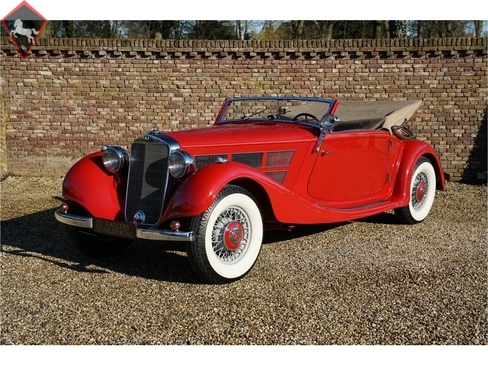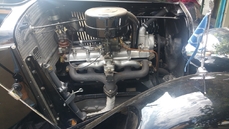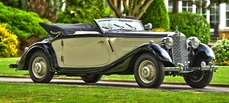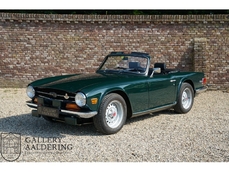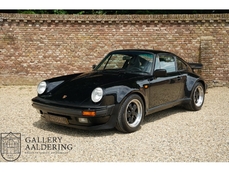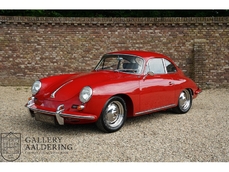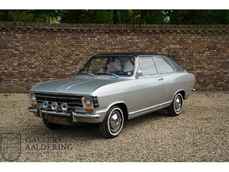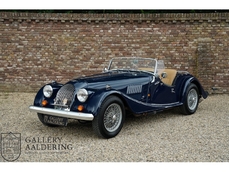Mercedes-Benz 320 (1937-) 320 A CABRIOLET Fully restored 1939
General description :
If you were successful in the 30’s of the last century, you really only had one choice. You would be looking for quality and only the best would do, or as Mercedes-Benz put it so nicely: “Das beste, oder nichts”. The Mercedes-Benz 320A was a very advanced car, positioned directly below the 500K and 540K Roadster. It was a somewhat compact car with a straight-six instead of the eight-cylinder with Kompressor. The A was the most sporty version in the 320 series. In fact it is the “Junior” model of the unobtainable 540K Roadster. The car is a proper 3-seater with two in the front and a jump seat placed transversely in the back. The hood was mode to exacting standards allowing the car to be used in all seasons. The car was manufactured in Mercedes-Benz Mannheim factory that would later be destroyed in the 2nd world war. Our Mercedes-Benz 320A first entered the Austrian roads in 1939. The car has undergone a full specialist overhaul and restoration in Germany. The top quality charisma it had in 1939 has completely been restored to its former glory. In consequence the bodywork is in perfect shape. The chassis has also been perfectly restored according to the original specifications. The panelwork is nice and thin with perfect alignment. The enormous “suicide” doors also shut faultlessly. Then there is the fantastic and very well cared for brightwork. The flawlessly resprayed red paintwork is unblemished. Inside the high quality restoration continues. The doors and seats are clad in supple light-brown leather and lovely wood. All gauges and controls are similarly in excellent condition and work without fault. From the drivers seat your eye falls on probably the most fabulous detail of the Mercedes-Benz 320A, it drivers side spotlight that also serves as a rearview mirror. Everything about this car radiates top-class pedigree. The finish, the material used, the ergonomics are all of an exceptionally high level. The car has a fine 3.4 litre straight-six petrol engine. It produced for its day a very respectable 77 PS and still allows the Mercedes-Benz 320A to get along nicely in today’s traffic. The engine has a manual 4-speed transmission with the desirable overdrive. The brakes are supported hydraulically all-round allowing for ease of use. Even though the car is 82 years old, it has lost none of its elegance and style over the last eight decennia. That the car has enjoyed very good care and attention lately is certainly noticeable when driving. Step in and luxuriate in the top quality only a Mercedes-Benz from that era can offer you. Gallery Aaldering is Europe’s leading Classic Cars specialist since 1975! Always 400 Classic and Sportscars in stock, please visit http://www.gallery-aaldering.com for the current stock list (all offered cars are available in our showroom) and further information. We are located near the German border, 95 km from Düsseldorf and 90 km from Amsterdam. So easy traveling by plane, train, taxi and car. Transport and worldwide shipping can be arranged. No duties/import costs within Europe. We buy, sell and provide consignment sales (selling on behalf of the owner). We can arrange/provide registration/papers for our German (H-Kennzeichen, TÜV, Fahrzeugbrief, Wertgutachten usw.) and Benelux customers. Gallery Aaldering, Arnhemsestraat 47, 6971 AP Brummen, The Netherlands. Tel: 0031-575-564055. Quality, experience and transparency is what sets us apart. We look forward to welcoming you in our showroom
1939 Mercedes-Benz 320 (1937-) 320 A CABRIOLET Fully restored is listed for sale on ClassicDigest in Brummen by The Gallery for €415000.
Car Facts
Car type : Car Make : Mercedes-Benz Model : 320 (1937-) Model Version : 320 A CABRIOLET Fully restored Engine size : 0.0 Model Year : 1939 Sub type : Convertible Location : Brummen Vehicle Registration : Undefined
415000 €
People who viewed this Mercedes-Benz 320 (1937-) also viewed similar Mercedes-Benz listed at ClassicDigest
Other cars listed for sale by this dealer
About Mercedes-Benz
In the annals of automotive history, the journey of Mercedes-Benz is a tale that unfolds with the ingenuity of its founding pioneers. In the year 1886, Karl Benz crafted the Benz Patent Motorwagen, a creation that would go down in history as the world's inaugural automobile. Unbeknownst to him, this moment marked the genesis of what would evolve into the most illustrious premium car manufacturer globally. The financial underpinning of this pioneering venture, interestingly, was provided by Karl Benz's wife, Bertha Benz, demonstrating a remarkable partnership that would set the tone for Mercedes-Benz's legacy.A parallel narrative emerged not far away, as Daimler-Motoren-Gesellschaft, founded by Gottlieb Daimler and Wilhelm Maybach, entered the scene. In 1901, they unveiled their automobile under the now-famous moniker "Mercedes," meaning "godsend" in Spanish. This name was bestowed upon the car at the behest of Emil Jellinek's daughter, the distributor for Daimler-Motoren-Gesellschaft. The wheels of innovation were set in motion.
Fast forward to 1926, a pivotal year that witnessed the merger of Daimler with Benz & Cie., culminating in the birth of Daimler-Benz. The amalgamation saw the adoption of "Mercedes-Benz" as the distinguished trademark for their automobiles, fusing the legacies of two visionary entities into one.
Contrary to perceptions of conservatism, the trajectory of Daimler-Benz unfolds as a chronicle of industry firsts. From the introduction of the honeycomb radiator to the float carburetor, and the pioneering implementation of four-wheel brakes in 1924, Daimler-Benz consistently pushed the boundaries of automotive innovation. The diesel-powered Mercedes-Benz 260 D in 1936 marked the inception of diesel engines in passenger cars. The iconic Mercedes-Benz 300SL Gullwing made history as the first car with direct fuel injection, albeit the Gutbrod's tiny 2-stroke engine can claim precedence.
Safety innovations became a hallmark, with Béla Barényi's patented safety cell design in the "Ponton"-models in 1951, featuring front and rear crumple zones. The W116 450SEL 6.9 saw the introduction of the Anti-Lock Brake system (ABS), another pioneering safety feature. From the first production airbags and beyond, the legacy of "firsts" continued to be etched into the fabric of Daimler-Benz.
Over its centennial journey, Mercedes-Benz has not merely produced cars but has sculpted automotive icons. The SSKL, 710 SSK Trossi Roadster, 770K Grosser, 540K Spezial Roadster, 300SL Gullwing, w100 600 Pullman, w111 280SE 3.5 Flachkühler, w113 230SL Pagoda, w109 300 SEL 6.3, and w201 2.3-16 Cosworth stand testament to the brand's commitment to engineering excellence.
The roaring Silver Arrows, or "Silberpfeile," including the W 25, W 125, W154, W165, and W196, created a legacy of dominance on the racetrack. These machines were not merely cars; they were expressions of precision, speed, and an indomitable spirit that left their competitors in the dust.
As Mercedes-Benz marches into the future, it does so not just as an automaker but as a custodian of a legacy, a torchbearer of innovation, and a beacon of automotive excellence. The road ahead is sure to witness the continued fusion of cutting-edge technology, timeless design, and an unwavering commitment to setting new standards in the world of automobiles.
One luminary figure who left an indelible mark was Béla Barényi, often heralded as the "father of passive safety" for his pioneering work in safety engineering. His patented safety cell design, featuring front and rear crumple zones, became a hallmark of Mercedes-Benz's commitment to occupant safety, setting new standards that reverberated throughout the automotive world.
Moving through the chronicles, the collaborative genius of Wilhelm Maybach, alongside Gottlieb Daimler, laid the foundation for Daimler-Motoren-Gesellschaft. Their innovations not only birthed the first Mercedes but established a culture of relentless pursuit of technological excellence that remains integral to Mercedes-Benz's DNA.
In the post-merger era of 1926, Ferdinand Porsche emerged as a prominent figure within Mercedes-Benz. His work on the Mercedes-Benz S-Type, a supercharged race car, garnered acclaim and set the stage for a legacy that extended far beyond the marque. Porsche's impact would later extend to his eponymous company, but his influence at Mercedes-Benz during those formative years was pivotal.
As the 20th century progressed, the legendary Rudolf Uhlenhaut emerged as a key figure. Uhlenhaut, an accomplished engineer and the driving force behind the iconic Silver Arrows, played a crucial role in Mercedes-Benz's dominance in motorsports. His engineering prowess and attention to detail were instrumental in creating some of the most formidable racing cars of the era.
In the latter half of the century, figures like Bruno Sacco, the head of design at Mercedes-Benz from 1975 to 1999, left an indelible imprint on the brand's aesthetic identity. Sacco's design philosophy, characterized by clean lines and timeless elegance, shaped iconic models like the W126 S-Class and the W201 190E, solidifying Mercedes-Benz's reputation for luxury and sophistication.
The narrative would be incomplete without acknowledging the contributions of engineers like Hans Scherenberg, whose leadership in the 1970s ushered in a new era of technological innovation at Mercedes-Benz. Scherenberg's tenure saw the development of groundbreaking technologies, including the Anti-Lock Brake system (ABS) and the introduction of airbags in production cars.
